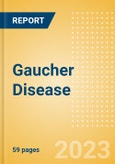Currently, the marketed treatment regimen for Type 1 GD and Type 3 GD is dominated by ERTs and SRTs (Cerezyme, VPRIV, Elelyso, Cerdelga, Zavesca).
There are several unmet needs in the GD landscape, including the lack of effective therapies for treating the neuropathic manifestations presented by Type 2 GD and Type 3 GD patients.
The GD R&D pipeline offers some innovative products, including gene therapy and venglustat malate, which is expected to be the first brain-penetrant SRT.
Steady market growth is expected throughout the forecast period as the GD population slowly increases and diagnostic approaches improve.
Key Highlights
Report deliverables include a PowerPoint report and Excel-based forecast model.Forecast includes 7MM: US, 5EU (France, Germany, Italy, Spain and the UK) and Israel.
Forecasts cover 2022-2032.
Scope
- Overview of GD, including epidemiology, symptoms, diagnosis, and disease management.
- Annualized GD therapeutics market revenue in 7MM (US, 5EU and Israel), annual cost of therapy and treatment usage pattern in 2022 and forecast for 10 years to 2032.
- Key topics covered include strategic competitor assessment, market characterization, unmet needs, clinical trial mapping and implications for the GD therapeutics market.
- Pipeline analysis, comprehensive data assessing emerging trends and mechanisms of action under development for GD treatment. The most promising candidates in late-stage development are profiled.
- Analysis of the current and future market competition in the 7MM GD therapeutics market. Insightful review of the key industry drivers, restraints, and challenges. Each trend is independently researched to provide a qualitative analysis of its implications.
Reasons to Buy
- Develop and design your in-licensing and out-licensing strategies through a review of pipeline products and technologies, and by identifying the companies with the most robust pipeline.
- Develop business strategies by understanding the trends shaping and driving the GD therapeutics market.
- Drive revenues by understanding the key trends, innovative products and technologies, market segments, and companies likely to impact the GD therapeutics market in the future.
- Formulate effective sales and marketing strategies by understanding the competitive landscape and by analyzing the performance of various competitors.
- Identify emerging players with potentially strong product portfolios and create effective counterstrategies to gain a competitive advantage.
- Organize your sales and marketing efforts by identifying the market categories and segments that present maximum opportunities for consolidations, investments, and strategic partnerships.
Table of Contents
Companies Mentioned (Partial List)
A selection of companies mentioned in this report includes, but is not limited to:
- Sanofi
- Genzyme
- Takeda
- Pfizer
- Actelion
- Freeline Therapeutics
- Prevail Therapeutics
- Johnson & Johnson








